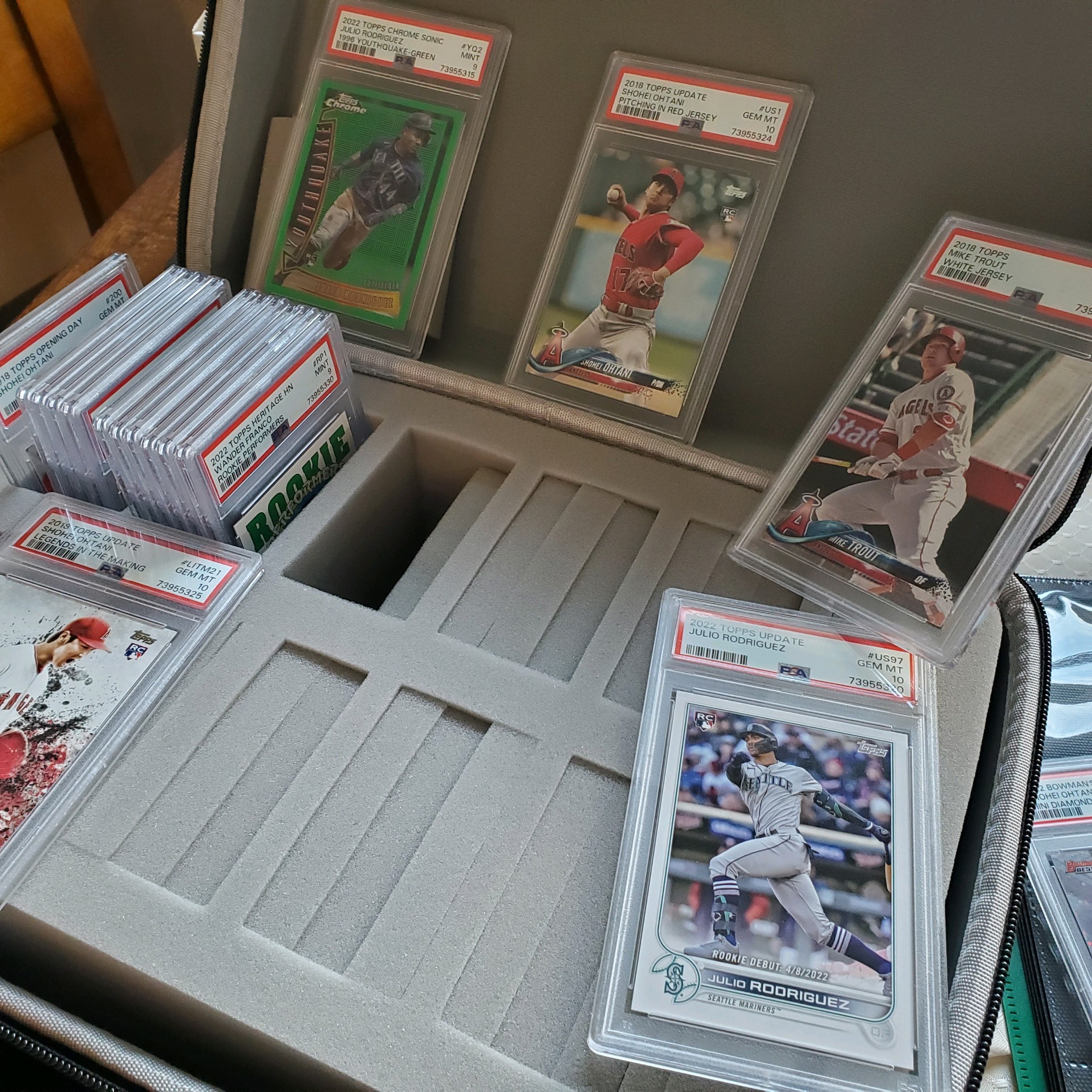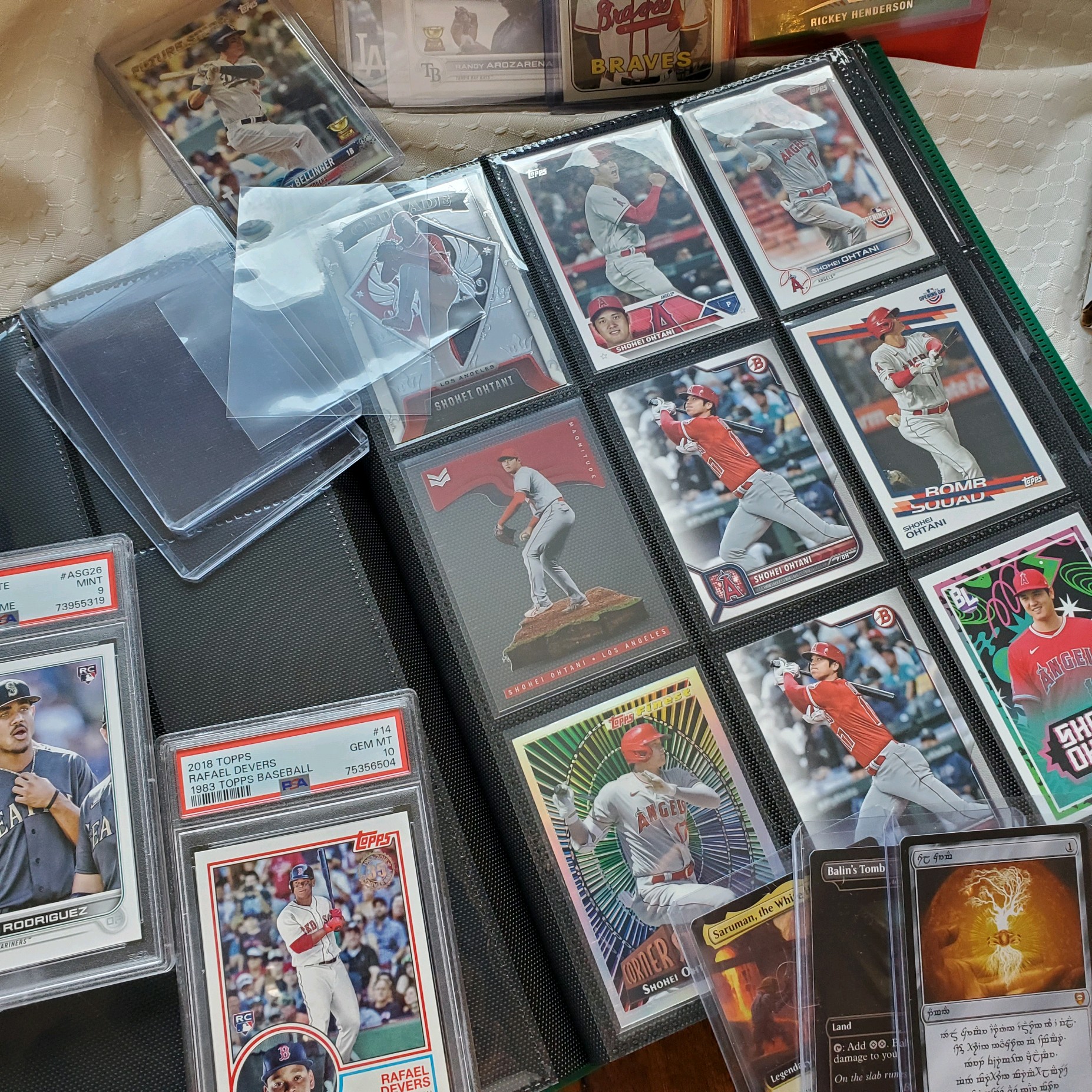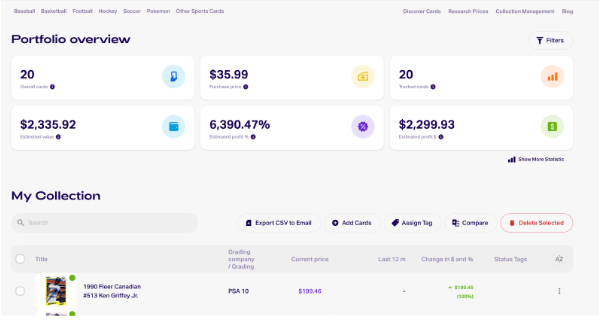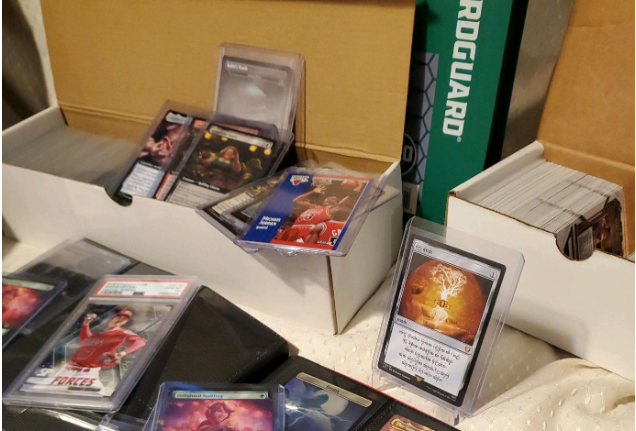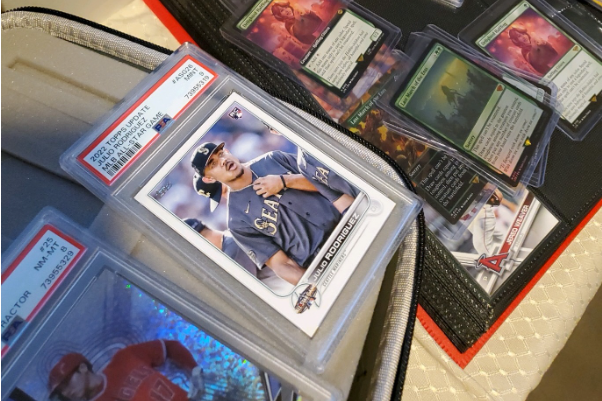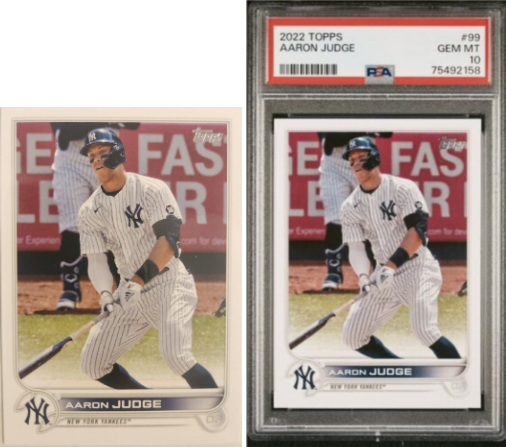Contents
Show/Hide
- Card Storage Basics: Where and How to Store Trading Cards
- Maintaining the Best Storage Conditions: Where to Keep Your Collection
- Safeguarding Your Card Collection
- Proper Card Handling: Preventing Wear and Tear
- Displaying Your Collection: Showcasing Safely
- Boosting Your Card Collection's Value
- Storage and Care: Part of the Trading Card Hobby
Card Storage Basics: Where and How to Store Trading Cards
If you’re reading this article, you probably know that even a minor difference in the condition of a card can lead to a massive drop in value. The value of a graded PSA 10 Gem Mint card versus a PSA 9 Mint card can be massive. Knowing this should encourage collectors and investors alike to ensure they always properly store their trading cards, especially when they have not yet been professionally graded and placed on a slab that provides strong protection from harm. Improper storage can lead to damaged cards that have little to no value for collectors or investors.
Proper basic storage considerations fall into three main categories: Card sleeves, card storage Containers, and the location where you store your card.
Using Card Sleeves and Toploaders
Sleeves are clear plastic pockets that protect individual cards from wear. Use them in conjunction with storage boxes, binders, or another solution to protect your cards. Sleeve recommendations include:
- The Right Type of Sleeve: Look for sleeves made of polyethylene or polypropylene plastic for durability and chemical stability instead of PVC, which has plasticizer chemicals that can damage cards.
- Sturdy and Correctly-Sized Sleeves are Worth It: Choose thick, rigid sleeves rather than flimsy “penny” ones. Those pennies you save when buying cheap sleeves will cost you in the end. Also, ensure you buy trading card-sized sleeves because there are a lot of options with various game cards out there. A good sleeve fit will help.
- Top-Loaders are the Final Touch: Putting that sleeve into a rigid top-loader provides the most protection. Yes, twice the sleeves means twice the protection.
Ever seen a knight without their armor? Well, that’s what your cards without their sleeves and/or toploaders are like. They offer protection against dust, scratches, and accidental spills. Whenever possible, make sure you have your cards in their sleeves when you handle them to avoid the oils and dirt on your hands from damaging your trading cards.
If you want to learn more about this, read our guide about How To Find The Perfect Top Loader For Your Sports Cards
Card Storage Containers
The right storage box can be the key to ensuring the safety of your trading cards. Think of this as the main storage component for your cards, kind of like their home where your cards can safely reside, shielded from harmful external elements.
Storing in Storage Boxes
The generally preferred method for bulk trading cards are boxes that allow you to neatly organize stacks of cards in sleeves or top-loaders. These containers come in sturdy plastic or archival quality cardboard. Either of these options can work out well, and different sizes are available to accommodate your collection being organized by type.
Ensure boxes are clean and free of dirt, oils, or environmental contaminants. Avoid cardboard boxes with acidic content that can migrate to cards. Keeping cards vertical in these boxes with a layer of protection all around is ideal for maintaining your cards in good shape while being stored.
Storing Cards in Binders
Binders are a popular storage option as they allow you to visually display and access your collection but you must be cautious when storing cards in them. Flimsy binder pages stored improperly can lead to knicks and scratches on cards that will devalue your cards quickly. If you prefer to use a binder over boxes for ease of transportation or another reason, follow these tips:
- Use D-ring binders rather than an O-ring or round ring, as they reduce the risk of scratches by doing a superior job of keeping the binder sheets in place.
- Limit the number of binder pages to less than half capacity to avoid warping and creasing cards.
- Be selective about which cards go in binders, as the pages can still lead to some wear over time. Avoid storing high-value vintage or mint cards in binders long-term.
Binders can be used for storage, just be cautious when you use them and extra cautious during transit.
Maintaining the Best Storage Conditions: Where to Keep Your Collection
Your trading cards are delicate treasures that definitely don’t belong in the damp, dark corners of your garage. Where you store your boxes can be as important as the packages they are in. Keep your card storage areas cool and dry, ideally at around 65-70°F with 45-50% relative humidity or as close to these conditions as possible. Here are some additional tips for ensuring your trading cards are being stored optimally:
- Avoid Direct Light: Avoid storing your cards in direct sunlight, as UV rays can fade the colors and weaken the cardstock
- Protect From Pollutants: Minimize exposure to cigarette smoke, chemicals, foods, and other environmental pollutants.
- Keep Moisture Away: Use silica gel desiccant packs in boxes and cabinets to absorb excess moisture. Moisture can lead to mold growth and other detrimental effects.
Safeguarding Your Card Collection
Keeping a clear inventory of your cards that documents each card plus their condition and values is an important part of making sure you protect your investment. Cardbase is an ideal way to keep an online backup copy of your collection, the price you paid, and the current market value of your trading cards. This way, if there is any dispute about what you have in the case of theft or some kind of loss, you have an electronic record of what you own off-site and away from your home.
The Collection Management dashboard within Cardbase provides you a quick view of your collection’s total value, costs, and profits. This simple interface is ideal for efficient collection management and valuation.
As you acquire new cards, keep up with your inventory easily with card scanning and include card details during that process so you always know what you have. This becomes all the more important as your collection grows and it can be easy to miss an opportunity for a new acquisition or the chance to sell an item when the time is right.
Sure, you can keep all this information on a spreadsheet or in a physical ledger. A physical record is better than no record at all. The advantages of a digital copy through Cardbase are many, including having that off-site record of your collection, insight into value, and the ease of updating. Take all of this seriously into account when you make your decision about how you will store your collection.
You may also consider keeping your most valuable cards in a bank safe deposit box. While this prevents you from displaying and enjoying your cards, if you are concerned about secure storage in your location, this can remove your worries about losing your most prized possessions and the bank will be fully insured on their end.
Trading Card Insurance
Insurance is another key consideration for collectors and investors alike. Check your homeowner's or renter's insurance policy to ensure the full value of your collection is included. Sometimes you will need to get a policy ‘rider’, which is a special addition to a policy to make sure collectibles are covered and not just subject to the overall value they put on your household items in the case of catastrophic damage. Most insurance companies will allow this kind of policy adjustment for a small fee to make sure you are covered.
If your policy does not offer this option, there are also specialty insurance companies that will insure collections separately for a reasonable fee. It’s a good idea to protect what you have if your trading card collection is worth more than your policy deductible.
Proper Card Handling: Preventing Wear and Tear
Handling trading cards of value should be done with the utmost care. This will help preserve value and keep cards, particularly ungraded ones, in the best condition. Here are some essential tips for proper handling:
- Wash Hands: Make sure to wash your hands thoroughly before handling your trading cards. This will remove any oils, dirt, or residue that can transfer onto the cards and cause damage.
- Avoid Direct Contact: Whenever possible, hold the cards by their edges to minimize the risk of smudging, bending, or scratching any surfaces.
- Use Gloves: For particularly valuable trading cards, consider wearing cotton or nitrile gloves to provide an extra layer of protection against fingerprints or accidental damage.
Displaying Your Collection: Showcasing Safely
While it is essential to store your trading cards properly, we like to show off our collections! Here are some key tips to help display your collection so your friends and visitors can admire them:
- Acrylic Display Cases: These cases offer protection from physical damage while allowing for an unobstructed view of your cards. Find cases with UV protection to safeguard against harmful sun rays, especially if you are displaying your cards in a room with a lot of sunlight.
- Framed Displays: Increase the visual appeal of your cards by framing individual cards or sets. Ensure that you use acid-free matting and UV-protective glass to maintain the pristine condition of your cards.
- Shelving Units: If you prefer a more accessible display option, shelving units with adjustable shelves can provide an elegant way to showcase your trading cards without compromising their safety.
Boosting Your Card Collection's Value
Storing and taking good care of your cards is a major component of ensuring you preserve the value of your collection. So is getting your cards graded by a professional organization.
Grading Your Cards
Card grading can be a game-changer in terms of the value of a trading card. If an independent party like PSA or BGS has reviewed the quality and condition of your card, that validation can increase the value massively. That said, grading cards has a cost associated with it and if the cards are not going to be worth enough, they will not be worth grading. The cost of grading cards can vary, the companies that provide this service also can offer sales and bulk discounts at times, too. If you want to learn more about this, read our Guide about When or When Not To Grade Your Trading Cards.
Even with these deals, it can be at least $15 to much more for each card to be judged, graded, and put on a slab before being mailed back to you. This process takes weeks, too, so be prepared to wait a bit depending on the load the grading company is currently handling.
Is Grading Your Cards Worth It?
High-quality, desirable cards will always be worth grading. However, less popular cards or cards in poor condition are probably not worth grading unless they are really old and popular. Research grading criteria if you are not familiar with the standards PSA, BSG, and others expect.
For example, this 2022 Aaron Judge card is listed for $1.25 at an online auction. No one has bid on it at this price. However, the card on the right is the same card, same year - but it has been graded as a PSA 10 Gem Mint. That copy sold for $59.99. Maybe the first card is in great shape, but collectors and investors trust the professional opinion of a third-party company with experience affirming the quality of trading cards.
If you still aren’t sure if your cards will be worth enough to get them professionally graded, Cardbase can be a huge help here. By looking up your trading cards on Cardbase, you can see the value of the card at different grading levels by selecting the drop-down list that shows you what the card has been sold for at marketplaces across the web. If the card doesn’t look like it will be graded very well, you may not want to spend the money to get the card graded. This tool can save you a lot of time and hassle.
Keep Those Graded Cards Unopened
If you do get your cards graded, keep them on their slabs and do not open them. Unless you are getting the card autographed or professionally reviewed for some reason, do your best to not break open a card that has been graded. This will generally require that the card be re-graded and can reduce its value.
Storage and Care: Part of the Trading Card Hobby
Once upon a time, in the era of bubble gum baseball cards and swapping cards with your friends at school, trading cards were just a fun pastime and not something to be taken seriously. Sure, you wanted to collect all the cards in a set, but that was a challenge to amuse you, not for profit.
Those days are long gone. Trading card collections can be worth millions of dollars - even a single card can be worth millions. The record is still $12.6M for a 1952 Mickey Mantle baseball card. That record will fall and cards will continue to increase in value. You need to take good care of your cards because they are both a wonderful way to connect with sports or games you love, but they are also an investment.
By taking the proper precautions outlined in this article, your trading card collection will remain well-protected and you can expect it to appreciate in value over the long-term. Safeguard your cards in rigid top-loader and archival supplies, control temperature/humidity, limit exposure to elements, organize intuitively, and grade the best of your cards to increase their value.
Trading cards are a connection to the past, popular artwork, and a treasure to be enjoyed. With proper storage and care, your trading cards will be preserved for years of collecting enjoyment and they can become something you can even pass down to your children and grandchildren as a valuable asset and a connection to their family’s past. Happy storing!
